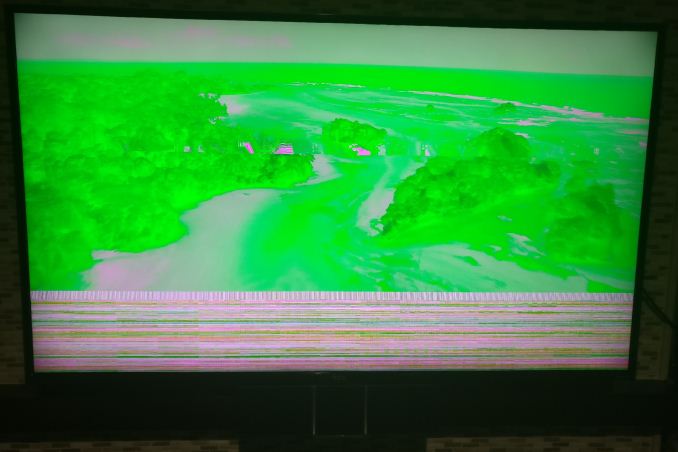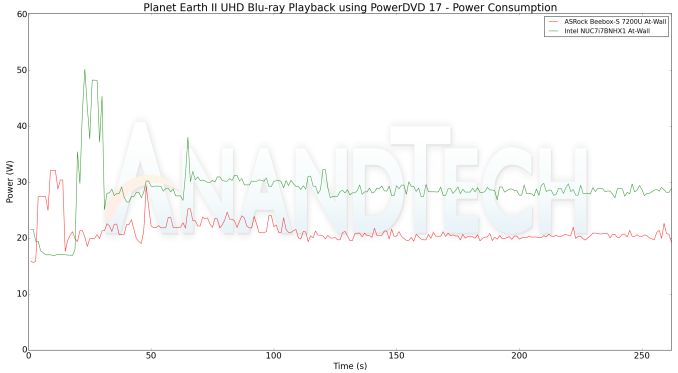A Budget Home Theater & PC Setup: 4K, HDR, UHD Blu-ray, and More
by Ganesh T S on December 26, 2017 8:30 AM ESTUHD Blu-ray Playback in Action
Prior to testing out HDR UHD Blu-ray playback using the TCL 55P607 and the Denon AVR X3400H, we did a trial run with the LG 43UD79-B monitor. The playback was flawless in SDR mode. Emboldened by these results, we moved the hardware to the home theater setup. At that time, the Windows 10 Fall Creators Update was yet to be released. Intel and CyberLink had adopted their own scheme to activate HDR in full screen mode while playing back HDR-enabled titles. Unfortunately, the TCL 55P607 (on firmware version 7.7.0 at that time) did not really like the mode switch.
Corrupted HDR Display with TCL 55P607 Firmware v7.7
I reached out to both Intel and TCL with the above results. While the latter simply washed their hands off the issue, Intel was very responsive. They went to the extent of even sourcing the same display to check at their end. Around the same time, TCL released a firmware update (v8.0.0 4127-30) that resolved the problem.
By the time I was able to upgrade my TV, Windows 10 Fall Creators Update had released and Intel's 4877 driver had also become public. My next testing round had interesting results. The 4877 driver had flawless desktop and streaming HDR, but, playing back the Planet Earth II title resulted in a BSOD, or a PowerDVD crash, or a message indicating that PowerDVD was denied access to the graphics hardware. With an older driver version (4771), I was able to play back the Blu-ray with HDR, but, had no desktop or streaming HDR.
On checking with Intel again, it became evident that the issue was specific to the Planet Earth II title. They provided me with early access to a driver slated for release in January 2018. This driver enabled both the Intel NUC7i7BNHX and the ASRock Beebox-S 7200U to successfully play back the Planet Earth II Blu-ray with HDR, while also performing as per specifications in our other tests detailed in the previous sections.
Note that the Pioneer BDR-211UBK comes with an OEM version of PowerDVD 14 that does support 4K UHD Blu-ray playback.
We tracked the power consumption of the set (PC + Blu-ray drive with the SATA-USB bridge) while playing the first chapter of the first disc in the Blu-ray set (after a full menu loop).
We find that the Beebox-S 7200U is more power efficient for this particular task. The NUC7i7BNHX is much more versatile with its Thunderbolt 3 ports, Optane support, and other bells and whistles. Can those make a difference in a generic HTPC setup? We will address that in our concluding section.













191 Comments
View All Comments
Bullwinkle-J-Moose - Thursday, December 28, 2017 - link
Quote from edzieba....."That's... not how things work. At all. Adding an S/PDIF cable is not going to magically allow transport of audio streams that:
a) Are too high bitrate for S/PDIF (which cannot even carry 5.1 LPCM)
b) Were developed decades after the S/PDIF standard "
----------------------------------------------------------------------------------------------
You seem to be forgetting that "I make the standards for MY Home Theater Setup" / Not You!
I was designing multi-channel Audio Systems before "your" alleged standards existed
You are once again thinking you must use what the market dictates, even when the market standard is pure CRAP!
I build for "MY" standards which seem to be considerably higher than yours
gerz1219 - Tuesday, December 26, 2017 - link
By that logic, why even bother adding an AVR? You could just use the built-in TV speakers.The point of this article is to lay out what equipment is necessary to enjoy all the latest home theater formats and features. Keeping your old 720p plasma from 2008 is always the "budget" solution for people who don't need the latest and greatest. That's irrelevant in the context of this article.
Gasaraki88 - Wednesday, December 27, 2017 - link
You obviously don't know anything about new technology. TOSLINK is not going to pass Dolby Atmos and DTS:X from the TV to the receiver.So get out of here.
Bullwinkle-J-Moose - Friday, December 29, 2017 - link
"You obviously don't know anything about new technology. TOSLINK is not going to pass Dolby Atmos and DTS:X from the TV to the receiver."-------------------------------------------------------------
LOL, I obviously do
I created better standards than Dolby ever did and was doing it before Dolby ever created their very first surround format
I simply choose to get better audio imaging accuracy through carefully matched drivers, hybrid crossovers and components and custom circuitry
I could easily encode audio to the vast majority of new technology "Standards" you ramble on about but can easily surpass the imaging accuracy of others by using a higher standard........
My own!
But for a "BUDGET" Home Theater system, I cannot personally make a better speaker than the JBL LSR305
and I DO NOT need an AVR if I will not be using the pseudo Standards of others
Tell me, if the "New Technology" you speak of is the "Standard" that everyone must use, then what EXACTLY is NEW and why so many "Standards" ?
Reflex - Friday, December 29, 2017 - link
I can't wait to try all the content coming out in the BJM standard!Bullwinkle-J-Moose - Friday, December 29, 2017 - link
"I can't wait to try all the content coming out in the BJM standard!"---------------------------------------------------------------------------------------
It may be a long wait
Much of the best tech fails in the audio market
Blatant Lies, slick/false advertising and pseudo standards usually win in the marketplace
Does that make them better?
Reflex - Friday, December 29, 2017 - link
It's just not important. The content is being mastered in Dolby Atmos. It's reasonable to build a system that supports that so that I don't miss out. No clever component choices nor ideal speaker placement can change the fact that if I'm running a setup that isn't Atmos capable it won't generate Atmos effects when I play back such content. And quite frankly Atmos is the biggest leap in audio I've seen since 5.1 first hit.I'm glad what you have works for you. If that's all you need there is nothing wrong with that. For myself after trying Atmos at a friend's I wanted it at home and it was well worth the upgrade.
JSStewart - Thursday, January 4, 2018 - link
Hokey smokes, who cares what a stupid moose troll thinks?I will go with the squirrel any day.
wiyosaya - Friday, January 5, 2018 - link
It's called technological progress.wiyosaya - Friday, January 5, 2018 - link
or even DTS HD-MA or Dolby TrueHD